How to groom a dog: A vet's guide to brushing, bathing and clipping
Our vet tells you how to groom a dog at home and keep your canine companion healthy and happy
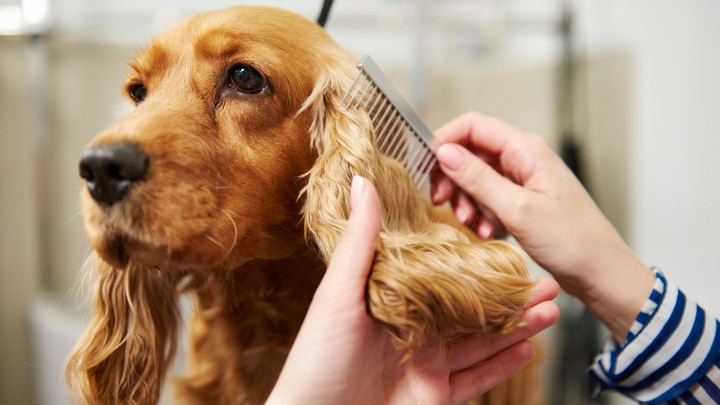
Perhaps you’ve got a new puppy and need to know how to groom a dog. Or maybe you’re affected by COVID restrictions, and you can’t visit the groomer anymore. Either way, you probably need to know how to look after your dog’s coat.
Some dogs need brushing daily, others don’t need as much care – it all depends on your dog’s coat type. You’ll need to get yourself one of the best dog brushes you can find and also consider bathing, clipping, and brushing your dog’s teeth. Use the time to check your dog over carefully for lumps, skin problems, and ticks, as well as for bonding with lots of cuddles and treats.
How to restrain your dog for grooming
Before you go ahead and start grooming your dog, you’ll need to make sure your dog is safely restrained. Most dogs learn to tolerate grooming well, but even if they love it you should still restrain them, as moving at the wrong time could be dangerous! The easiest way to restrain your dog for grooming is by enlisting a friend to hold them still for you.
Ideally, they should be able to position the dog by encouraging them to stand, but the most important thing is that they prevent the dog from moving suddenly, and have some control of the head. If you don’t have an easily-available extra pair of hands, you can buy harnesses and dog tables designed to hold your dog still whilst you groom them. If you’re only brushing your dog, it’s unlikely these tables will be needed, but if you’re clipping, using scissors, or cutting their nails, good restraint is essential.
Some dogs will dislike grooming enough that a muzzle might be necessary as a safety measure. It’s a good idea to teach your dog to enjoy wearing the muzzle to reduce stress – positive muzzle training is useful for this!
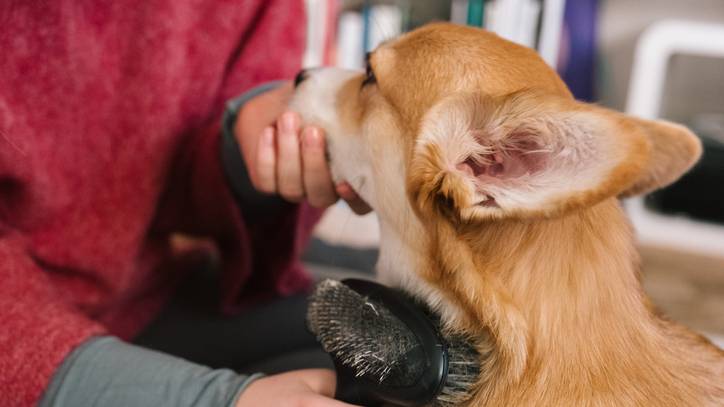
Brushing your dog
The cornerstone of grooming is a good brush. Just like in humans, brushing keeps the hair from becoming tangled and matted, which can be uncomfortable and lead to sore skin. It also spreads the skin oils over the coat to improve water resistance and shine.
Different dog coat types have different requirements. For short-haired dogs, you may get away with brushing weekly. Longer-coated dogs will need brushing more often – and sometimes daily! Choose the right brush and the right method to avoid hurting your dog when brushing them.
Get the best advice, tips and top tech for your beloved Pets
Get the right brush for your dog's coat
There are a lot of different types of dog brush, and you need to find the right one to suit your dog’s coat. Most dogs will need a soft bristle brush at some point, so getting one of those is a good place to start. Dogs with a long coat will also need a rake or metal comb to remove the tangles. Double-coated breeds and those prone to shedding may need an undercoat brush. You’ll find a slicker brush useful for curly-coated breeds such as poodles and poodle-crosses. Wire-haired dogs may need a stripping knife- although in my experience it’s best to leave stripping to a groomer!
How to brush your dog
If your dog isn’t used to being brushed, you may need to introduce them to it slowly. Show them how fun it is by providing plenty of the best dog treats and praise. Many dogs can be a bit nervous about their legs or underside being groomed, so it’s best to start with the neck and shoulders – areas that they’re used to being touched. Work backwards, over the back, and then down the sides to the undercarriage. You can then gently brush the face and head if needed.
For most dogs, a once-over with a soft bristle brush and a quick detangle of problem areas with a comb is all they need. You’ll soon work out how often your dog needs brushing, and also where your dog’s trouble areas are – check under the armpits and in the groin for tangles, and spaniels and other long-eared dogs are prone to getting matts behind their ears.
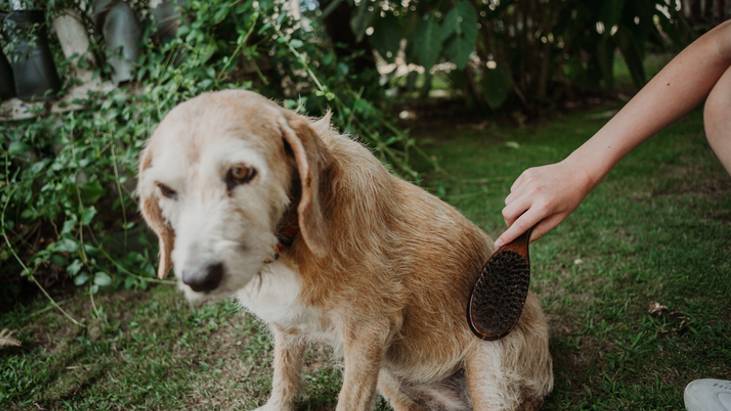
Cutting and clipping your dog's coat
Whilst you might prefer to leave the cutting of your dog’s coat to a breeder, you may find you have to have a go yourself at times. Short-coated breeds and smooth coats rarely need clipping, but longer coats and poodles will often need regular clipping.
If you’re going to clip your dog’s coat yourself, you should get a pair of electric clippers (human ones are fine) with varying guard lengths. It may take some practice to find the right guard length for your dog – it’s best to start with the longest guards and change them down until you get the length you want. Avoid using scissors unless you are very experienced, as sharp objects can be dangerous if your dog wriggles.
Getting your dog used to the clippers
If your dog isn’t used to having his coat clipped, especially if you have a new puppy or a rescue, you may need to practice a few times until they aren’t afraid of the clippers. Many dogs are afraid of the noise they make!
Just as with anything new and potentially scary, you should start as small and innocuous as possible – perhaps simply holding the clippers up, turned off, for them to see – then giving them a treat. Work up slowly to avoid scaring your dog. When you do start clipping, avoid the head and ears, as many dogs will be frightened by the buzzing of clippers behind their ears.
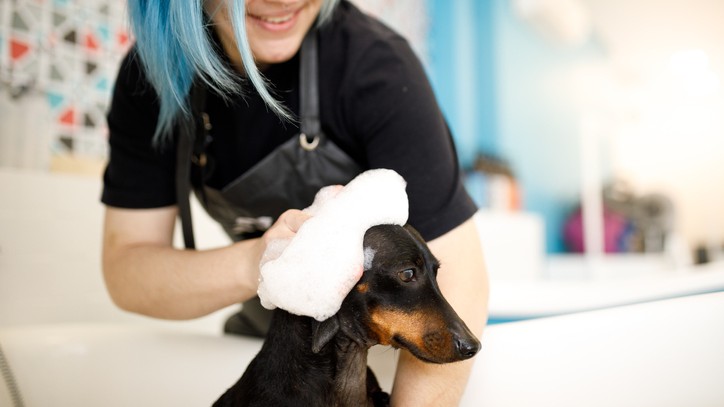
Bathing your dog
Some dogs will need more regular bathing than others. Dogs that have skin problems such as allergies may need twice weekly bathing, whilst many others will only need doing when they’re dirty – although if you own a white dog that loves the mud you might still find yourself bathing your dog regularly!
Try not to bathe your dog too often – most shampoos will strip natural skin oils and cause skin problems. Unless they’ve rolled in something, have become very dirty, or have a medical condition, look to bathe your dog more than once a month.
Choosing the right shampoo for your dog
Any generic dog shampoo will be suitable for most dogs – take a look at our guide to the best dog shampoo. Try to find one with fewer ingredients and fragrances to reduce the chance of your dog reacting to the shampoo. If you have a puppy, choose puppy shampoo, which is very gentle. Itchy dogs should have different shampoos too – either a soothing shampoo (oatmeal and aloe vera are my favourite ingredients) or a medicated shampoo recommended by your vet.
How to bathe your dog
Depending on the size of your dog, you may want to use a bathtub, sink, or special tub to bathe your dog in. Dogs can also be bathed in the shower, especially if you have a walk-in shower. Make sure you use warm, but not hot- water, as this will make it more pleasant for your dog. Despite this, many dogs will be scared of the bath the first time – give lots of praise, fuss, and treats to help them cope.
Wet your dog thoroughly, being sure to wet the undercoat. Then apply the shampoo. Massage in and leave to work according to the instructions on the bottle. Make sure you rinse thoroughly to avoid causing skin problems.
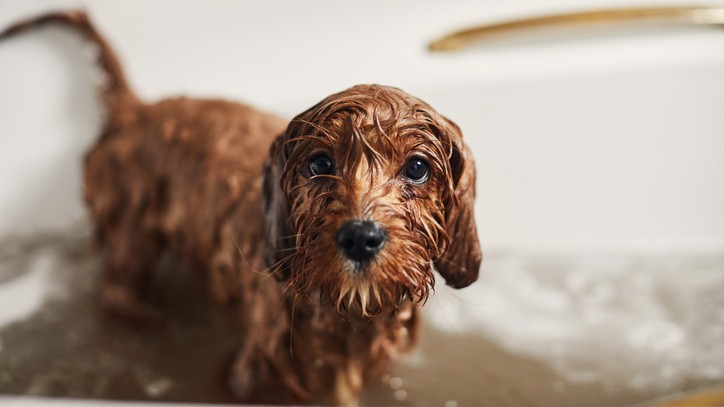
How to groom your dog’s face
When it comes to grooming your dog’s face, this is sometimes best left to the professionals. Using clippers, scissors, and other tools so close to the eyes can be dangerous. You’re also likely to be very close to your dog’s face, which they find intimidating and threatening. It’s difficult to muzzle a dog for grooming their face, so if you feel at all unsure you should talk to a professional groomer.
For many short-haired dogs, you don’t need to groom their face at all. Since most dogs dislike having their faces groomed, it’s best to leave well alone if it doesn’t need doing. If your dog has longer hair — particularly if it’s growing into and around their eyes and obscuring their vision — you may need to use a pair of scissors to very carefully trim the fur away and neaten it up.
- Ask a partner to hold your dog still, as any movement could be dangerous
- Your non-dominant hand should gently grasp your dog’s muzzle to steady them and prevent them from sudden movements. Take care not to obstruct the airways — short-nosed dogs in particular will dislike having their snouts held. Again, if you can’t do this safely it’s best left to the professionals — grooming injuries can be serious
- Rest the heel of your dominant hand on your dog’s cheek or just below their ear. This helps steady your hand and ensures you move with them if they move, which reduces the chance of eye injury.
- Trim the hair around the eyes, being careful to point the scissor tip away from your dog at all times.
- Follow the same process for trimming the beard, if necessary.
Other grooming care
Don’t forget your dog’s teeth! Toothbrushing should ideally be undertaken daily using a soft brush and a canine toothpaste. Dogs can be taught to tolerate toothbrushing from a young age, or with lots of praise and treats.
Similarly, nail clipping is an important part of your dog’s grooming routine. Check the nails weekly, looking for signs of them growing too long – they may curl over into the pad, click along the floor, or have a large length of nail after the pink quick. Use sharp clippers to cut the nail to 4mm past the end of the quick. If your dog has black nails, our handy guide on how to brush a dog’s teeth can help.
Conclusion
So, now you know how to groom a dog! With monthly baths and clips, weekly nail checks, and daily brushing of the coat and teeth, your dog will be kept in tip-top condition even when the groomer is closed. Don’t forget to take it slow so that you don’t frighten your dog, especially when these things are new to him.
After graduating as a vet from the University of Nottingham in 2016, Dr. Joanna Woodnutt went on to practice companion animal medicine in the Midlands. She quickly developed a love of consulting and helping clients with medical problems such as dermatology, behavior and nutrition - anything that involved helping clients understand their pets better.
Jo started writing about pet health in 2017, realizing that it meant she could help even more pet parents. Since then, she has written for countless online and print publications and is a regular contributor for Edition Dog Magazine. Jo is the director of The Veterinary Content Company, which she founded in 2020. She is also the founder of Petlearnia, a platform that provides pet e-learning courses for pet parents.
Jo now lives in the Channel Islands with her husband Ian and terrier Pixie.

